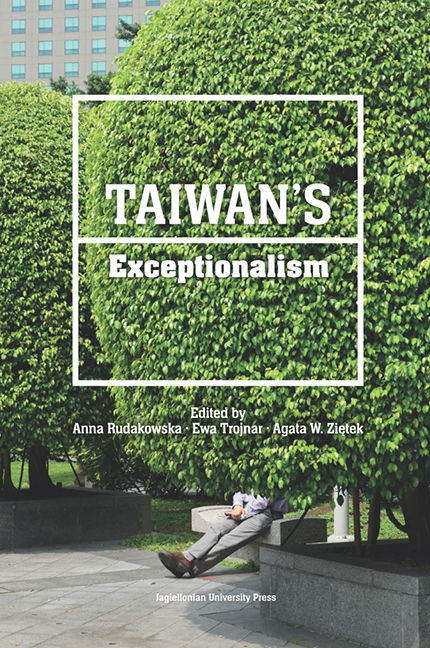Book contents
- Frontmatter
- Contents
- 1 Unpacking Taiwan's Exceptionalism: Themes and Studies
- 2 The Legal Status of Taiwan under International Law
- 3 Taiwan’s Unique Position Toward the South China Sea
- 4 Taiwan-China-United States Relations: Taiwan’s Unique Safe House for Better or Worse
- 5 Exceptionalism under a Glass Ceiling? Taiwan’s Democratic Development and Challenges
- 6 The Sunflower Movement: An Example of the Dynamics of Civic Activity in Taiwan
- 7 The Development of Indigenous Tourism Clusters in Taiwan: Economic and Cultural Foundations of Sustainability
- 8 A Shark Paradise in Taiwan (Dis)appears: From Shark Soup to Shark Diving
- 9 Taipei’s Soft Power at Work: The Image of Taiwan in Polish Dailies “Gazeta Wyborcza” and “Rzeczpospolita”
- Contributors
- List of Figures
- Index
6 - The Sunflower Movement: An Example of the Dynamics of Civic Activity in Taiwan
Published online by Cambridge University Press: 16 July 2022
- Frontmatter
- Contents
- 1 Unpacking Taiwan's Exceptionalism: Themes and Studies
- 2 The Legal Status of Taiwan under International Law
- 3 Taiwan’s Unique Position Toward the South China Sea
- 4 Taiwan-China-United States Relations: Taiwan’s Unique Safe House for Better or Worse
- 5 Exceptionalism under a Glass Ceiling? Taiwan’s Democratic Development and Challenges
- 6 The Sunflower Movement: An Example of the Dynamics of Civic Activity in Taiwan
- 7 The Development of Indigenous Tourism Clusters in Taiwan: Economic and Cultural Foundations of Sustainability
- 8 A Shark Paradise in Taiwan (Dis)appears: From Shark Soup to Shark Diving
- 9 Taipei’s Soft Power at Work: The Image of Taiwan in Polish Dailies “Gazeta Wyborcza” and “Rzeczpospolita”
- Contributors
- List of Figures
- Index
Summary
Abstract: The goal of this paper is to define the place of the Sunflower Movement in the context of the development of Taiwanese civil society. The movement was an informal popular mobilization that revealed the shortcomings of the existing formal channels of political participation. But was it also proof of the development and increasing maturity of Taiwanese civil society? To answer this question, the author places the Sunflower Movement in the context of mainstream civil society concepts, which helps to inform further reflection about the nature of civic activism in Taiwan. This, in turn, allows us to analyze the extent to which the Sunflower Movement fits the criteria of civic activism and the degree to which it has introduced a new quality to Taiwanese political life.
Keywords: Sunflower Movement, Taiwan, democratization, civil society
Introduction
The Sunflower Movement was an emanation of complex changes both in the relations between Taiwan and the People's Republic of China and in the internal politics of Taiwan. After March 2014, Taiwanese policymakers had to face questions concerning not only the framework of future talks with the Mainland, but also, just as importantly, the social perceptions of the government's actions. The inability of the ruling Kuomintang (KMT) to adapt to changing social circumstances signaled by the protests and the Democratic Progressive Party (DPP)'s skillful political offensive – partly based on the momentum created by the demonstrations – gave the latter party both the majority in the Legislative Yuan and the Presidential office for the first time since the lifting of martial law (1949–1987).
However, the Sunflower Movement should not be viewed as the underlying cause of changes in Taiwan's political landscape. Regardless of how the sit-ins and occupation of government buildings are perceived, the Movement should be viewed as a reference point signaling an important change in Taiwan's contemporary political history. And regardless of whether its legacy will survive or whether it will be politically exploited and diminished, it has already highlighted some major, important characteristics of Taiwanese democracy.
First and foremost, Taiwanese democracy is too strong not to be ignored in high-level diplomacy between Taipei and Beijing. Taiwanese citizens do not accept any form of ‘managed democracy.’
- Type
- Chapter
- Information
- Taiwan's Exceptionalism , pp. 117 - 132Publisher: Jagiellonian University PressPrint publication year: 2022



